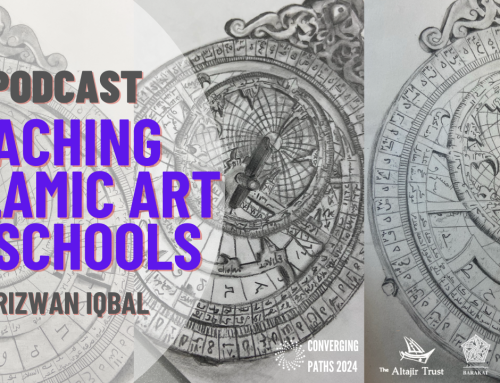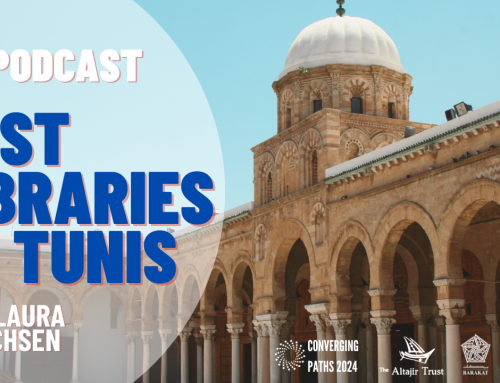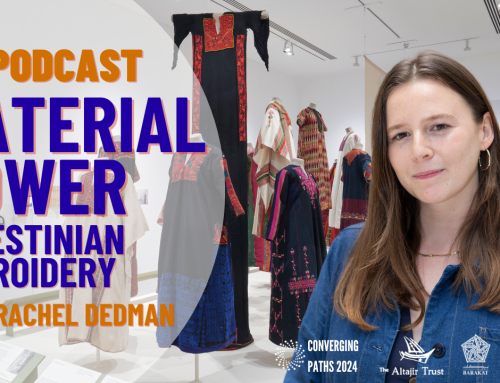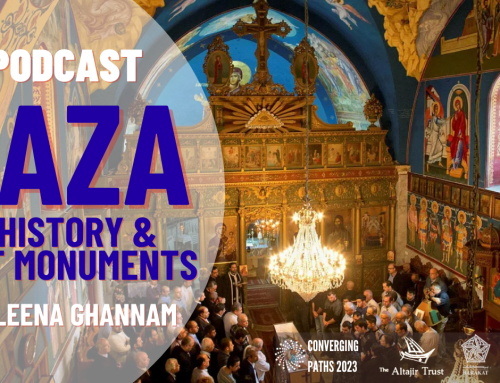Converging Paths has launched a new initiative to enable audiences to ask their burning questions about the artistic culture of the Islamic world to leading experts in the field. This is also a great opportunity to get an insight into the professional and day-to-day life of our specialists.
This month, Zeynep Yürekli, Associate Professor of Islamic Art and Architecture, University of Oxford, and member of The Barakat Trust’s Academic Advisory Committee answers our questions.
Her interests are: Ottoman art and architecture, Sufi art, and manuscripts.
The interactions between the Ottoman and Mamluk courts had a long history before the Ottoman conquest of 1517. Cairo was an important centre of learning where many Ottoman religio-legal bureaucrats visited in search of knowledge, craftsmen from Mamluk lands found employment in pre-Ottoman as well as Ottoman Anatolia, and artifacts including textiles were exchanged as gifts between the two courts. Ottoman visual arts developed in dialogue with the Mamluk world, as well as the Timurid/Turkmen courts in the east and Europe.
It is difficult to assess the impact of the Ottoman conquest on the textile industry in Egypt, as the Mamluk textile industry had its peak under private patronage in the fourteenth century but then saw a sharp decline by the early fifteenth century, long before the Ottoman conquest. There was, however, a thriving rug industry in Egypt which continued after the conquest. Interestingly, rather than the Mamluk rugs with geometric designs changing the taste in Istanbul, the Cairene workshops adapted themselves to the prevalent Ottoman taste and started producing carpets with floral designs in the mid sixteenth century. This is not surprising, given that this was a period when taste was quite heavily influenced by the Ottoman court workshops, as designs made by court artists in Istanbul were applied onto various media including textiles, tiles and rugs produced in semi-independent workshops outside Istanbul, which also catered to civilian customers.
The Ottoman author Gelibolulu Mustafa ‘Ali, writing in the late sixteenth century, highlighted how different the manners and costumes of Cairenes were as opposed to what he was accustomed to in Istanbul. One way of comparing costumes worn in different cities of the Ottoman empire would be to look through costume albums made from the sixteenth century onwards. Differences in costumes depicted in Ottoman manuscripts produced in Istanbul, Aleppo and Baghdad may also give clues. Yet unfortunately, we will probably never know what most people really wore in the sixteenth century, because apart from royal items kept in museums, the garments themselves have not survived.
Some sources where you might find answers to this question:
Bethany J. Walker, ‘Rethinking Mamluk Textiles’. Mamluk Studies Review 4 (2000), pp. 167–217.
Gwendolyn Callaço, ‘Dressing a City’s Demeanour: Ottoman Costume Albums and the Portrayal of Urban Identity in the Early Seventeenth Century’. Textile History 48 (2017), pp. 248–267.
Suraiya Faroqhi and Christoph K. Neumann, Ottoman Costumes: From Textile to Identity. Istanbul: Eren, 2004.
Sources for this period are few and not entirely reliable. What we do know is that the Rum-Seljuk capital Konya was populated by people of diverse ethnic backgrounds, with a lot of interaction between them. The political classes under the Seljuks and Muslim principalities (beyliks) included individuals of various ethnicities. The patronage of these individuals, as well as conversions, marriages and trade, contributed to making the boundaries between ethnic groups very porous especially in the larger cities. However, the situation may have been very different in rural areas. There are references in twelfth-century Byzantine sources to nomadic Turks who were moving across the Anatolian plateau according to seasons, and they seem to have had a separate life from the settled populations.
Much later records from the Ottoman period show that there was a certain concentration of non-Muslim ethnic groups in particular neighbourhoods in urban settings, but it is difficult to tell whether this had always been the case. Some of this was no doubt the result of Ottoman sürgüns resulting in emigres from particular rural areas being settled in the same neighbourhood. Recent research suggests that the boundaries between the social realms of Muslims and Christians in medieval Anatolian urban society may have been, though not entirely non-existant, more fluid than they would be in the later Ottoman empire.
The identification as Roman (or Rumi) could be adopted by individuals of any ethnicity, and could mean different things according to context. Ways of urban life probably played a greater role than ethnicity in an individual’s identification with a particular community. A Tukish-speaking city dweller may have felt a closer affinity with Greek denizens than with the nomads.
Some sources where you can might answers to this question:
Cemal Kafadar, “A Rome of One’s Own: Reflections on Cultural Geography and Identity in the Lands of Rum”. Sibel Bozdoğan & Gülru Necipoğlu, History and Ideology: Architectural Heritage in the “Lands of Rum”, pp. 7–25. Leiden: Brill, 2007.
Speros Vryonis. The Decline of Medieval Hellenism in Asia Minor and the Process of Islamization from the Eleventh through the Fifteenth Century. Berkeley and London: University of California Press, 1971.
A.C.S. Peacock, Bruno de Nicola and Sara Nur Yıldız (eds), Islam and Christianity in Medieval Anatolia. London: Routledge, 2016.
What we call ‘progress’ is often defined by a Eurocentric view of history which sees the Industrial Revolution that occurred from the late eighteenth century onwards in a positive light, because of its role in what is seen as the triumph of Western culture over the East. The Industrial Revolution brought about new methods and materials of production, which indeed changed matters profoundly in art and architecture. However, this was to the detriment of ‘traditional’ means of training, production and patronage pretty much everywhere in the world (including Europe), not just in the Islamic world.
In the aftermath of the Industrial Revolution, many art forms and modes of production in Europe were marginalised into the realms of ‘traditional art’, ‘minor arts’ or ‘vernacular architecture’ whilst sculpture and painting were elevated in status as individualistic art forms. Similarly, in the Ottoman empire, especially after the establishment of the Fine Arts Academy (Sanayi-i Nefise) on the model of the Beaux-Arts School in Paris, forms of Islamic art such as calligraphy and manuscript illumination were marginalised but continued to be practiced by traditional artists and craftsmen, who learned their trades in a master-to-apprentice chain of transmission through practice.
A source where you might find answers to this question:
Gözde Çelik (ed.). Geç Osmanlı Döneminde Sanat Mimarlık ve Kültür Karşılaşmaları. Istanbul: İş Bamkası Yayınları, 2018.
Calligraphy with Sufi content, architecture of Sufi convents, dervish objects like begging bowls, or any form of art practiced by a Sufi can be categorised under the rubric “Sufi art”. On its own, this term does not denote a particular art form or style.
Sufism encompasses widely different approaches to tasawwuf, which in the widest sense of the word is an approach to Islam that prioritises the quest for divine truth that is assumed to be hidden under the layers of everyday material things and social experiences. Sufis adopt different ways of doing this, usually under the guidance of a spiritual mentor known as shaykh. Because the methods are various, and sometimes contentious from the viewpoint of orthodox Islam, Sufi networks known as tariqas have had various positions in Islamic societies.
The rule of the Mamluks in Egypt and Syria (1250-1517) coincided with a wider phenomenon in the Islamic world that started before the Mamluks and continued after them, namely the institutionalisation and politicisation of Sufi tariqas. Many Sufi shaykhs in this period enjoyed the patronage of ruling elites, and the Mamluks were not an exception. Mamluk sultans and high officers built a number of monumental Sufi convents (khanqahs) as part of their multi-functional charitable complexes, especially in Cairo. The khanqahs accommodated resident dervishes and their rituals, as well as travellers who were either dervishes themselves or enjoyed the company of dervishes. These complexes were supported by endowments that provided for the upkeep of the buildings as well as the needs of the dervishes, so that they could focus on their quest for divine truth without worrying about how to sustain themselves.
It must be noted that given the aim of tasawwuf to affect a dissociation from the material world and its institutions, some Sufis were not happy with these developments. In particular, the need to dissociate from the material world and its institutions did not sit comfortably with the patronage patterns that defined Islamic art and architecture. In the Mamluk period, as elsewhere in the Islamic world, whilst some Sufis rejected patronage, others were well-connected in high places and enjoyed high-status patronage.
Sources where you might find answers to this question:
Leonor Fernandes. The Evolution of a Sufi Institution in Mamluk Egypt: The Khanqah. Berlin: Klaus Schwartz Verlag, 1988.
Ladan Akbarnia & Francesca Leoni. Light of the Sufis: The Mystical Arts of Islam. London and New Haven: Yale University Press, 2010.
Courtney Stewart. ‘Art of the Sufis’. Heilbrunn Timeline of Art History. New York: The Metropolitan Museum of Art, 2000–. http://www.metmuseum.org/toah/hd/sufi/hd_sufi.htm
Doris Behrens-Abouseif. ‘Craftsmen, upstarts and Sufis in the late Mamluk period’. Bulletin of the School of Oriental and African Studies 74 (2011), pp. 375–395.






